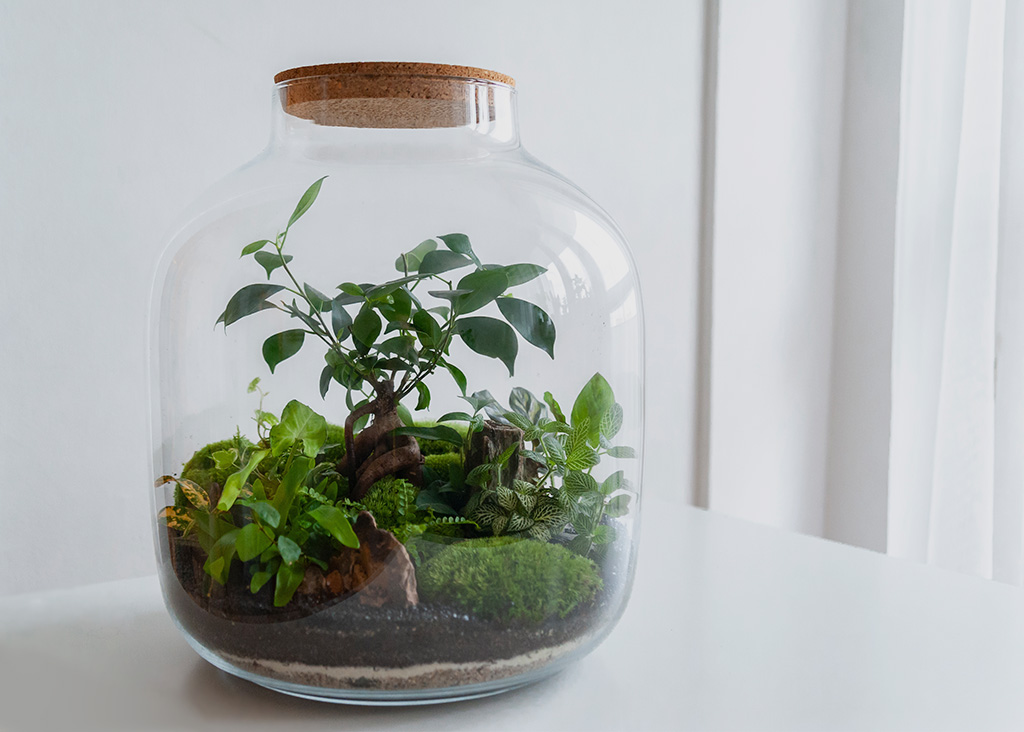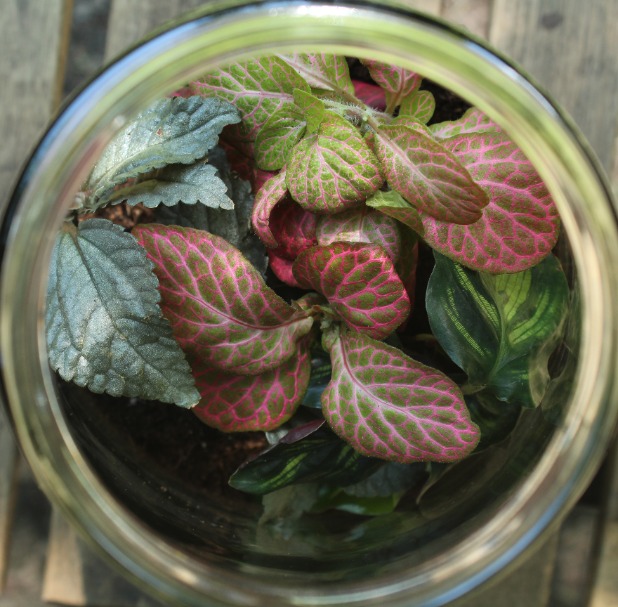
Deliver to
Germany
 English
EnglishEnter the magical world of plant terrariums and add more greenery to your living space or office! Terrariums are the perfect way to brighten up your interior.
Whether you are an experienced plant lover or taking your first steps in the world of plants. We are happy to help you care for and maintain it. This way you can enjoy your closed plant terrarium for a long time!
Don't have your own terrarium yet? We explain step by step how to make one yourself on this page: How to make a closed DIY plant terrarium
The best location for a closed plant terrarium is a spot with sufficient indirect sunlight. A spot with a window facing east or west is perfect.
However, always avoid a spot with direct sunlight, as this can burn the leaves of the plants. It is also best to avoid placing your terrarium near a north-facing window, as there is usually less sunlight there.
Additionally, it's important not to place a terrarium next to or above a heating source, such as a radiator. This can strongly influence the temperature within the closed terrarium, potentially causing stress to the plants.
Maintaining a consistent temperature is crucial for a healthy ecosystem. The best temperature for a closed plant terrarium is usually between 15 and 25°C.
Choosing the right location for your terrarium is essential for its care and lifespan. By paying close attention to the amount of light and the appropriate temperature, you can ensure that the plant ecosystem remains healthy and at the same time forms a beautiful addition to your interior.
Although you don't water a terrarium, it can still contain too much water. If a terrarium is too humid, you can tell by the amount of condensation on the glass. A healthy ecosystem contains condensation on one side of the glass. Is the entire glass surrounded by condensation? Or even dripped? Then we recommend airing the terrarium for 24 hours. You can temporarily remove the cork or lid, and then remove the excess water with a paper towel or a clean cloth. Repeat this process until you notice a reduction in the amount of condensation.
However, it's also possible that a terrarium might contain too little water. Does little or no condensation form on the glass of the terrarium? Then it may be a good idea to give a small amount of water. In most cases, this is necessary about once every six months, but it might be needed more frequently. After all, the intention is to create enough condensation in the terrarium. This is needed for a healthy ecosystem. We recommend adding between 5 and 10 cl of water if you think the terrarium contains too little water. Before you do this, we recommend checking whether the soil actually feels too dry.




Mould in a terrarium is very common, especially in the early stages when you have just created the terrarium. This is because the plants still need to get used to their new habitat and location. In a closed terrarium, the humidity is much higher than in an open space. Mould can grow in a closed terrarium just as effectively as it does in nature.
Moulds are actually only partially preventable. One of the proactive measures you can take against moulds is to add activated charcoal. Active charcoal has a filtering function, which prevents mould growth. There's hardly a better form of prevention!
Fortunately, within a thriving and healthy ecosystem, moulds keep themselves in balance. For example, leaves affected by mould can turn into compost, which can then serve as plant nutrition for the rest of the terrarium.
To prevent excessive mould growth, we recommend following our tips on location, temperature, water, condensation and ventilation.
Do you notice moulds growing on plant leaves or moss? Then it is wise to help the ecosystem a bit. This is because if you let the ecosystem take its course, the mould may spread from just a few leaves to several plants.
If you want to prevent this from happening, you can limit mould at an early stage by wiping the leaves with clean paper towels. Another option is to prune part of the plant and remove the mouldy parts from the terrarium.
If any plants or moss are completely mouldy, it is best to remove them entirely from the terrarium. When doing so, try not to touch other plants in the process, to avoid unnecessary spread of more bacteria. If some of the potting soil is also mouldy or if any mouldy parts of the plant or moss stays behind in the terrarium, remove it with paper towels. You can throw away the mouldy plants and replace them with fresh plants.
To reduce excess moisture in a terrarium, you can air the terrarium for 24 hours without a lid or cork. Then, you can close the terrarium again with the lid. Wait for another 24 hours and repeat the ventilation process multiple times if necessary. This approach helps the ecosystem gradually get used to the changed humidity.
Does it remain very humid inside the glass despite multiple ventilations? Then air the terrarium for 48 hours during this process, instead of 24 hours.
Does ventilation not help at all, and does a lot of condensation continue to form? You can also try drying the inside of the glass with some paper towels. That way, you can easily remove most of the moisture.
In addition, a small opening, slot or air hole can also help prevent excessive moisture. Excess moisture can be caused by a wrong location with too much sunlight and/or a too high temperature in the terrarium.
It's not a problem if some leaves of the terrarium plants turn yellow or brown. As in nature, a plant often sheds older leaves. This allows the plant to put its energy into growing new leaves. You will therefore see that discoloured leaves are often located at the bottom of the plant. Once a leaf is completely discoloured, it will fall off the plant by itself. This in turn will provide nutrition for the rest of the plants.
Would you like to remove the discoloured leaves yourself anyway? That’s also possible! Then cut off the entire leaf at the stem of the plant.
If a plant turns completely yellow or brown, it is best to remove it before it starts to mould. The yellowing or browning of the plant can have several causes. Both too much and too little moisture, as well as too much or too little light, can be a cause of plants turning yellow or brown.
The discolouration of moss is a natural process. As in the forest, changes also occur in a terrarium that can cause moss to change colour. This is largely due to changes in the humidity of the habitat. Moss needs high humidity to maintain its green colour. However, there is no need to worry if the moss in your terrarium has turned yellow or brownish. This usually resolves itself and otherwise you can lend a hand.
If the moss has become too dry, regularly spray it with a plant mister to increase humidity. It's best to take the moss out of the glass before doing so.
If this spraying is not enough, the moss probably needs more moisture. You can then remove the moss from the glass. Then put the moss in a container with water, so that the moss can absorb more moisture. When you see that the moss has absorbed the water, you can remove the moss from the water again. Gently squeeze the water out of the moss so that not too much water is left behind. Then you can put the moss back into the terrarium. You will see that it will regain its green colour!
If you think not just the moss, but the whole terrarium is lacking moisture, you can add a little water. We recommend adding between 5 and 10 cl of water if you think the terrarium is lacking moisture. Before adding any water, we recommend checking whether the soil actually feels dry.
If you find sluggish, small flies in your plant terrarium, they are usually fungus gnats.
Fungus gnats are small flies often found around moist, organic materials. They can breed rapidly in moist conditions, such as moist potting soil or compost from old leaves.
Fungus gnats aren't something to worry about, but eliminating them completely can be challenging. You can learn all about fungus gnats and how to get rid of them in this blog.
The formation and growth of fungi and mushrooms in a closed terrarium with plants is completely normal! Mushrooms are a form of fungi that form in the habitat of a healthy ecosystem, just like in nature. In general, it is certainly not something to worry about.
Despite this, an ecosystem does need to be in balance. Excessive growth of fungi and mushrooms in a terrarium can be indicative of too much moisture or insufficient ventilation.. Unwanted fungi can be removed to restore the balance.
Do you notice that a plant like Ficus Bonsai, Pilea or Calathea is getting too tall for the glass of your terrarium? Terrarium plants can be pruned just like normal indoor plants when they get too tall. Cut off the top leaves above another leaf or side branch. You will see that this stimulates growth and the plant will actually become more voluminous.
When pruning terrarium plants, always make sure the scissors you use are clean. Otherwise, you might accidentally spread bacteria by using it.